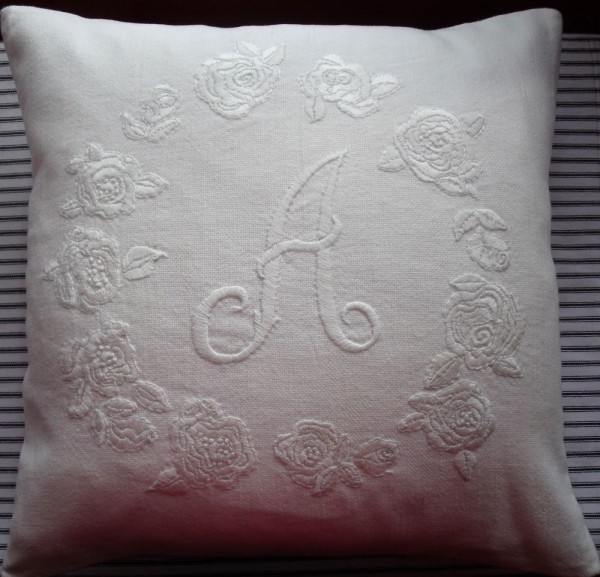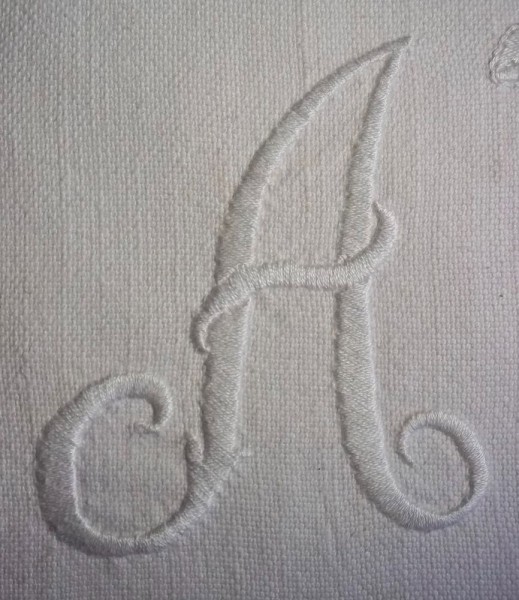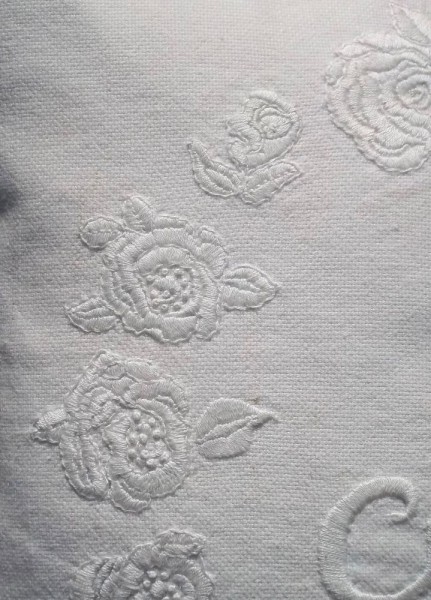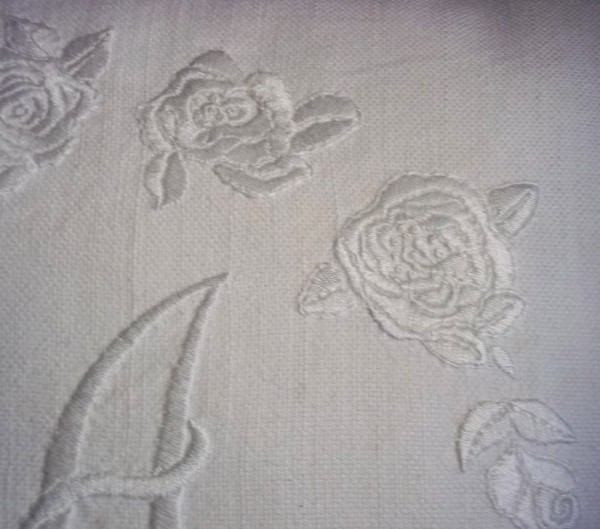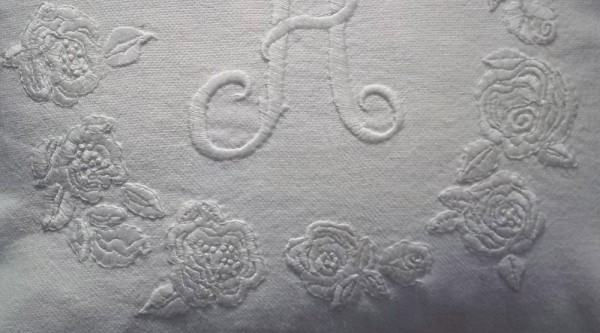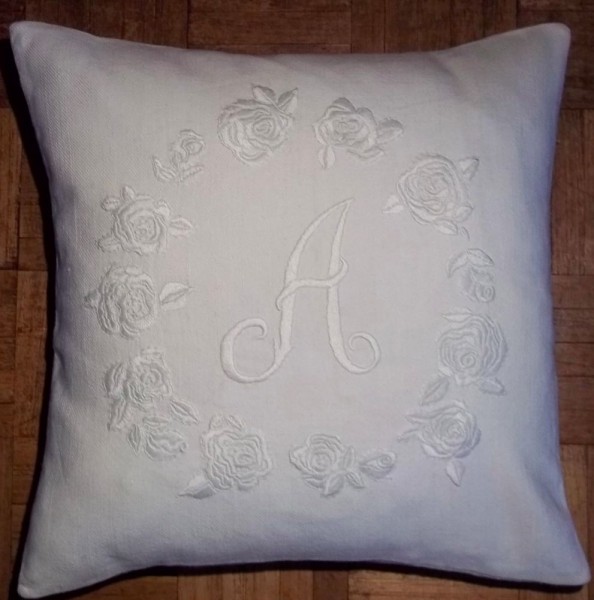A birthday present for daughter no 1 two years ago, this cushion has just been returned to me to be washed. At least this way, if anybody’s going to make a mess of it, it’ll be the one who made it. Anyway, who but mothers and lovers of fabrics have time for hand washing? The cushion is made of the old John Lewis Appleby Linen Union (55% linen/45% cotton -or the other way round) and embroidered in various different white embroidery threads. I washed it gently in Ecover clothes washing liquid, which I love and which is excellent for removing stains (pour a bit of liquid neat on to the stain, wait a while – which is not always necessary – and then machine wash as usual). I rinsed it well by hand and then put the cushion cover into the washing machine for a spin. As I have had my washing machine for all of a week, I got the programming wrong and ended up giving it another rinse, which I had intended to avoid, but it ended up being fine and the cushion cover emerged unscathed. I then dried it on a clean tea towel over a not very warm radiator. Before it was completely dry, I ironed it (with the iron inside the cover) and returned it to the radiator to finish drying.
When I was writing about the rose embroidered baby cardigan (27 January 2013), I came upon the following quote about roses from from chapter 2 of Aldous Huxley’s Brave New World,
“Big bowls, packed tight with blossoms. Thousands of petals, ripe-blown and silky smooth, like the cheeks of innumerable little cherubs…”
Being unable to tie this in with what I remember of the novel, I had to look it up and on looking it up, I couldn’t believe how I could have ever forgotten what I then read. In the novel, The Central London Hatchery and Conditioning Centre has the job of programming the masses to hate nature, on the one hand, and not to think too freely outside the thought pap delivered by the state, on the other, using what the book refers to as Neo-Pavlovian Conditioning. Babies are born (decanted from bottles) and when they are mobile are taken in groups into a room lined on one side with books and on the other with beautiful roses (as described above). Movement towards either set of objects triggers alarms and sirens which are accompanied by small shocks to reinforce the associative negative effect and, theoretically, to awaken feelings of fear at the very sight of books and roses ever after.
It is very odd. I have asked around if people who had read the book had any memory of this passage and so far I’ve not met anyone who has. It’s rather disconcerting and I haven’t yet come up with a reason why such a scene that so horrified me now should not have awakened the tiniest memory from my first reading of the book. Was I so much more insensitive to the pain of infants when I was a teenager? Or, perhaps it’s only when you have had children of your own, or nieces/nephews, or are fond of friends’ children, that this passage gives you any cause to pause and consider? I can get no further thinking about this and would be interested to hear what anyone else thinks.
Taking ‘rose’ and political theory off on another tangent, I recently came across this article in the New Yorker by Judith Thurman, entitled “A libertarian house on the prairie”. I read the Little House on the Prairie series of books by Laura Ingalls Wilder at least 3 times – once for each daughter, though it didn’t stop the older ones listening in. We loved the books, were bright eyed over descriptions of tapping trees for maple syrup, the making of rag dolls, patchwork quilts and new dresses but silently gulped back sobs when terrible things befell them in the later books where wizened potatoes were their only food, snow came through gaps in the boarding of the homstead walls piling high on their beds through the night and when Pa made ever longer journeys to find work with insubstantial shoes and thin clothing. I hadn’t realised that the books were written in collaboration with her only child Rose (Rose Wilder Lane) and that , although they were about Laura’s childhood, Rose was herself a published author and her influence in the books was paramount.
I should probably tell you not to read the article I’ve linked to, or to others written about mother and daughter by Judith Thurman as the opening of a window on the real life behind the books is one of mixed fortunes, with rather more on the negative side. However, Laura’s daughter, Rose Lane Wilder, does come across as an early feminist who, left alone after divorce and the death of her infant son, took her own situation in hand and set about putting her talents and enthusiasm to work to make a living for herself. She got into journalism and wrote pot boiler biographies of prominent figures – although she was no slave to accuracy and was sued by Charlie Chaplin. Her novels were successful in that they brought her an income but they never received the praise from the literary set which she so desired.
Politics became her next passion and this is where she begins to get interesting to us. In today’s politics libertarianism has had a revival as current political debate focuses on the extent to which the state should dictate how we live our lives and spend our money. Rose may have been the first person to use the term ‘libertarian’ to describe “nascent revolt against state authority” (and I’m quoting Thurman, not Rose here) which was a philosophy of individualism and self help; in practice this meant minimal social security measures and virtually no form of taxation. She was a friend of Ayn Rand who, for a few months last year was fashionable when cited as inspirational by Paul Ryan, Republican presidential running mate to Mitt Romney in the 2012 American Presidential Election. Interestingly, Rose fell out with Rand over the latter’s lack of religious belief for Rose could never quite eradicate the Biblical message to love thy neighbour as thyself. Her own history informed her belief for she thought the pioneers would have died in even greater numbers if they had resisted the urge to help each other and had lived out the philosophy of every man for himself. Whatever her broad political aims were, her personal ambition was to bring her income to the point at which she would no longer be liable for federal taxes. She succeeded in this by cutting down on her lucrative fiction writing and reducing her outgoings, growing her own food and making use of what she already had – in all returning to a pioneer life style (presumably without the fear of the original frontier existence).
Maternal passion led her into a series of complex relationships with those she regarded as protégés. She was subject to difficult episodes of depression and furious activity and would probably be diagnosed with bipolar disorder today.
After WWI, she was a correspondent for the American Red Cross, still reporting from Vietnam in 1965 when she was 78. She died in 1968. Her heir and adopted son, Roger MacBride, was the Libertarian Party’s candidate for President in 1976.
I have only touched on a little corner of this remarkable woman’s many achievements and I may have left the impression she was something of an intimidating virago. This would be grossly unfair as she was regarded by friends as a warm and witty companion both in conversation and in letters.
Life was not all politics and I was delighted to find that she found time to write a popular and commercially successful book on the history of needlework.

